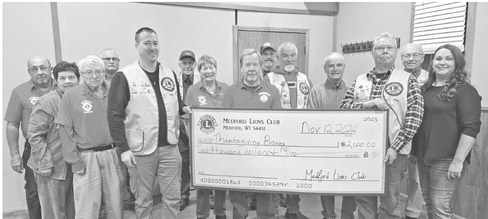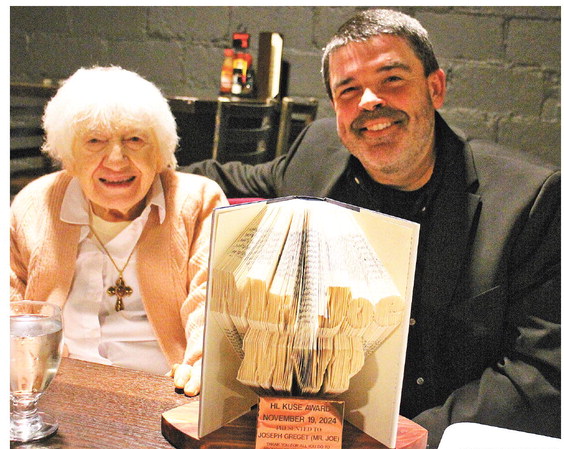Walcisak said he had some ….
Walcisak said he had some reservations about the carbon credit program noting that the county forests are already in place and that it is not the new forest land that would be needed to offset carbon pollution. “From an ethics point of view, I don’t agree with carbon projects,” he said.
“To a certain degree it is smoke and mirrors, but it is very lucrative smoke and mirrors,” he said. He said Bayfield County recently enrolled their much larger county forest land in the program and is generating about $1.5 million a year in carbon credit revenues, which are in addition to any harvest revenues. He said for Taylor County’s 15,000 of productive acreage, the rough estimate would be $100,000 a year of potential carbon credit revenue for 40 years.
He said the contracts are typically written that they would look at a payment of $2 to $3 million in the first year and small payments after that.
“There are very little downsides to this,” Walcisak said, noting that many surrounding counties are looking at this option. However, he cautioned that it was a complex issue.
Committee member Mike Bub agreed saying the county should proceed with caution and reminding committee members that when something appears too good to be true, it likely is. He said he has spoken to county board members from the areas that have enrolled in these programs and that there was opposition and concerns about the longterm control of the forests. “Be careful of who you are getting in bed with,” he said.
The administrator of the Bayfield county forest will attend the next forestry meeting to go over the process they followed. That county has been working with the carbon credit program for more than a year. Bub also raised concerns about the rules changing after the fact, noting that the large corporations who are controlling the carbon market typically get their way.
“It is just smoke and mirrors so that polluters can keep on polluting,” Walcisak said. However, the program would not be specific to the large corporations, and committee member Myron Brooks suggested that Dairyland Power, which operates a coal power plant that provides both Jump River Electric Cooperative and Taylor Electric Cooperative may have an interest in acquiring credits to offset carbon emissions.
Committee members will discuss it further at future meetings.
In other business, committee members:
_ Approved putting three timber sales out for bid. The sales total 248 acres, which is about half of the average yearly acreage put out for bid in the 18,000 acre county forest. The minimum bids for the projects total $124,061. The estimate was based on the current market conditions for the wood which is a mixture of northern hardwood, red maple and oak. In related action, committee members approved changes to the bid prospectus for the county to require all letters of credit to cover the duration of the contract plus an additional six months. They also changed that bids would be opened immediately after the due date of 3 p.m. at June 3. This procedural change will allow the staff to review the bids and prepare a comparison sheet for the committee to review at its meeting scheduled for June 4 when the bids will be formally awarded.
Walcisak explained that it is common to grant short term extensions at the end of the project to address site restoration or other issues. By including the additional time in the letters of credit at the beginning of the process it should save loggers time and money from having to extend them if the projects are not closed out by the completion date. The 84-acre sale 1-21 and the 116-acre sale 2-21 are for two years and the 48-acre 3-21 sale is for three years.
_ Approved extending timber sales 665 and 673 by one year and for 676 by two years. While Taylor County has been fortunate in recent years to get bidders for all of its logging projects, other counties have not been as fortunate. The extensions are due to current market conditions for the timber.
_ Discussed options for how to move forward with replanting of a 45-acre spruce plantation in the forest after receiving no bids for the work. The county had piggybacked on the Wisconsin Department of Natural Resources bidding hoping to attract a larger pool of contractors in what is a highly specialized field. The work includes trenching for planting and spraying to kill other plants. According to Walcisak there are two main companies out of Minnesota that do this work starting in the deep south in early spring and working their way north into Canada over the year. He said the largest county forests own their own equipment to do this, but noted it is expensive. He described it as being a large skidder with hydraulically controlled serrated disks similar to those used to bust sod. Bub suggested having the county forest association look into purchasing one to be shared among forests.
_ Discussed concerns about complaints of over harvesting in the county forest. The complaints came to committee chairman Chuck Zenner from county board supervisors who were not identified to the committee members. Zenner and committee member Gary Beadles (who has worked as a logger) toured the recently cut areas and reported that while there could have been a few things done differently, they did not see any drastic issues. The 15-year county forest plan, which is approved by the full county board, includes a minimum amount of acreage to be harvested each year. What is different is that in recent years, Walcisak said the portion being cut has been close to roadsides where it is more visible. He also noted that the increased mechanization of timber harvest has changed people’s perceptions. For example he said, it is not unusual to see four acres cut in a day.
“I was satisfied with what I was seeing,” Beadles said, noting he did not see damaged trees or other signs of poor management. “I think they have done a good job,” he said. “Overall it is a very healthy forest, a very pristine forest.”


